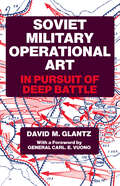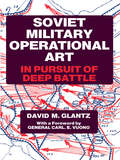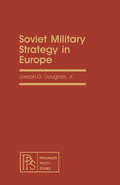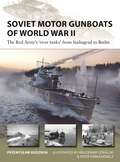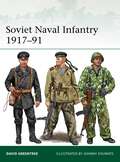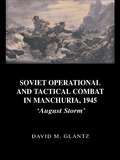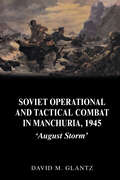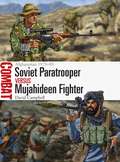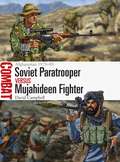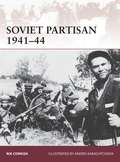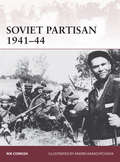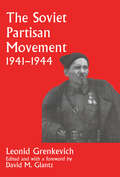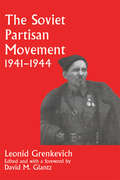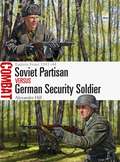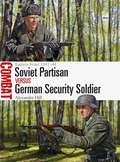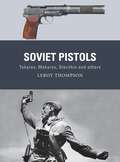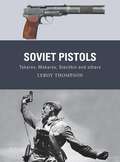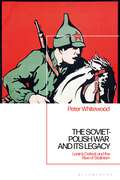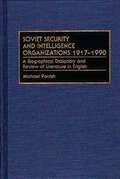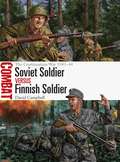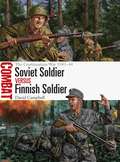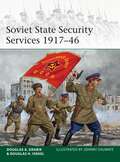- Table View
- List View
Soviet Military Operational Art: In Pursuit of Deep Battle (Soviet (Russian) Military Theory and Practice)
by Colonel David GlantzDavid Glantz examines the Soviet study of war, the re-emergence of the operation level and its connection with deep battle, the evolution of the Soviet theory of operations in depth before 1941, and its refinement and application in the European theatre and the Far East between 1941 and 1945.
Soviet Military Operational Art: In Pursuit of Deep Battle (Soviet (Russian) Military Theory and Practice)
by Colonel David GlantzDavid Glantz examines the Soviet study of war, the re-emergence of the operation level and its connection with deep battle, the evolution of the Soviet theory of operations in depth before 1941, and its refinement and application in the European theatre and the Far East between 1941 and 1945.
Soviet Military Strategy in Europe: An Institute for Foreign Policy Analysis Book
by Joseph D. DouglassSoviet Military Strategy in Europe focuses on the development, form and content, implications for international relations, and goal of Soviet military plan in Europe. The book first discusses the foundation of Soviet military thought and revolution in Soviet military affairs, including basic concepts of the Marxist-Leninist ideology, Soviet study of military affairs, nuclear revolution, and scientific and technical revolution. The publication also concentrates on Soviet study of laws and principles of military art and forces and primary operational concepts. Topics include laws of the first order, naval and air operations, nuclear strike, and conventional war considerations. The manuscript ponders on command and control, as well as combat modeling, survivability, coordination, centralization, and attack of NATO command and control. The book also reviews the issues of Soviet military strategy toward Europe and special Soviet problems. Topics include role of nuclear weapons, chemical warfare options, escalation to intercontinental war, NATO nuclear threat, nuclear weapon stockpile, and superiority and war initiation. The publication is a dependable reference for readers interested in the Soviet military scheme in Europe.
Soviet Motor Gunboats of World War II: The Red Army's 'river tanks' from Stalingrad to Berlin (New Vanguard #324)
by Przemyslaw BudzbonA compelling account of the heavily armed and highly mobile Soviet river gunboats which took on the Germans during World War II.Russia's enormous river system has long been its highway and, as early as 1908, the Tsar's armies were developing armoured riverboats that brought tank-like mobility, firepower and survivability to Russian battlefields.This book, the first history of these vessels in English, explains how this concept led to one of the most remarkable naval weapons of World War II, the Soviet 'river tank', or Armoured Motor Gun Boat (AMGB). Highly mobile, capable of carrying up to 20 infantrymen directly into action and providing immediate firepower from their tank turrets, machine guns or Katyusha rockets, their military value was widely recognized. They were versatile enough to be used in naval landing operations off the Gulf of Finland, the Azov Sea and the Black Sea, and their capabilities were prized by local commanders.Using meticulously researched new colour profiles, rare photos and spectacular artwork, this book uncovers the history of river warfare on the Eastern Front, and the boats that played such a key part in the fighting.
Soviet Motor Gunboats of World War II: The Red Army's 'river tanks' from Stalingrad to Berlin (New Vanguard #324)
by Przemyslaw BudzbonA compelling account of the heavily armed and highly mobile Soviet river gunboats which took on the Germans during World War II.Russia's enormous river system has long been its highway and, as early as 1908, the Tsar's armies were developing armoured riverboats that brought tank-like mobility, firepower and survivability to Russian battlefields.This book, the first history of these vessels in English, explains how this concept led to one of the most remarkable naval weapons of World War II, the Soviet 'river tank', or Armoured Motor Gun Boat (AMGB). Highly mobile, capable of carrying up to 20 infantrymen directly into action and providing immediate firepower from their tank turrets, machine guns or Katyusha rockets, their military value was widely recognized. They were versatile enough to be used in naval landing operations off the Gulf of Finland, the Azov Sea and the Black Sea, and their capabilities were prized by local commanders.Using meticulously researched new colour profiles, rare photos and spectacular artwork, this book uncovers the history of river warfare on the Eastern Front, and the boats that played such a key part in the fighting.
Soviet Naval Infantry 1917–91 (Elite)
by David GreentreeDrawing upon Soviet sources, this book assesses the evolving organization, uniforms, insignia, weaponry and personal equipment of Soviet naval infantry units from 1917 to 1991.Featuring eight plates of specially commissioned artwork alongside carefully chosen archive photographs, this study charts the history and appearance of the Soviet Union's naval infantry, from the October Revolution to the end of the Soviet era.Although Russian naval infantry achieved fame during the October Revolution they were quickly disbanded, only being re-established in 1939. Following the Axis invasion of 1941 some 500,000 Soviet Navy personnel served on land, fighting in the defence of Leningrad, Odessa and Sevastopol and the recapture of the Crimea in 1943–44; Soviet naval troops also participated in the invasion of Manchuria in 1945.During the Cold War era the Soviet Union developed an amphibious assault capability that had a vital strategic role – to capture an aggressor's geographical exits to the oceans and thereby forestall threats to Soviet submarine bases. Naval infantry forces could deploy a wealth of firepower assets, while the use of amphibious ships, hovercraft and helicopters aided their rapid deployment, even amid ice-bound terrain in the Arctic. All of these developments are described and illustrated in absorbing detail in this study.
Soviet Naval Infantry 1917–91 (Elite)
by David GreentreeDrawing upon Soviet sources, this book assesses the evolving organization, uniforms, insignia, weaponry and personal equipment of Soviet naval infantry units from 1917 to 1991.Featuring eight plates of specially commissioned artwork alongside carefully chosen archive photographs, this study charts the history and appearance of the Soviet Union's naval infantry, from the October Revolution to the end of the Soviet era.Although Russian naval infantry achieved fame during the October Revolution they were quickly disbanded, only being re-established in 1939. Following the Axis invasion of 1941 some 500,000 Soviet Navy personnel served on land, fighting in the defence of Leningrad, Odessa and Sevastopol and the recapture of the Crimea in 1943–44; Soviet naval troops also participated in the invasion of Manchuria in 1945.During the Cold War era the Soviet Union developed an amphibious assault capability that had a vital strategic role – to capture an aggressor's geographical exits to the oceans and thereby forestall threats to Soviet submarine bases. Naval infantry forces could deploy a wealth of firepower assets, while the use of amphibious ships, hovercraft and helicopters aided their rapid deployment, even amid ice-bound terrain in the Arctic. All of these developments are described and illustrated in absorbing detail in this study.
Soviet Operational and Tactical Combat in Manchuria, 1945: 'August Storm'
by David GlantzAt the request of the other Allies, on 9th August 1945, a force of over 1.5 million Red Army soldiers unleashed a massive attack against the Japanese in Manchuria. Volume 2 covers the detailed course of operational and tactical fighting in virtually every combat sector.
Soviet Operational and Tactical Combat in Manchuria, 1945: 'August Storm' (Cass Series On Soviet (russian) Military Experience #Vol. 8)
by David GlantzAt the request of the other Allies, on 9th August 1945, a force of over 1.5 million Red Army soldiers unleashed a massive attack against the Japanese in Manchuria. Volume 2 covers the detailed course of operational and tactical fighting in virtually every combat sector.
Soviet Paratrooper vs Mujahideen Fighter: Afghanistan 1979–89 (Combat)
by Johnny Shumate David CampbellIn 1979 the Soviet Union moved from military 'help' to active intervention in Afghanistan. Four-fifths of the Afghan National Army deserted in the first year of the war, which, compounded with the spread and intensification of the rebellion led by the formidable guerrilla fighters of the Mujahideen, forced the Soviets to intensify their involvement. The Soviet army was in generally poor condition when the war started, but the troops of the airborne and air assault units were better trained and equipped. As a result they developed aggressive, sometimes effective tactics against an enemy that refused to behave the way most Soviet commanders wished him to. Featuring specially commissioned artwork, this absorbing study examines the origins, combat role and battlefield performance of the Soviet Union's paratroopers and their Mujahideen adversaries during the long and bloody Soviet involvement in Afghanistan during the 1980s.
Soviet Paratrooper vs Mujahideen Fighter: Afghanistan 1979–89 (Combat #29)
by Johnny Shumate David CampbellIn 1979 the Soviet Union moved from military 'help' to active intervention in Afghanistan. Four-fifths of the Afghan National Army deserted in the first year of the war, which, compounded with the spread and intensification of the rebellion led by the formidable guerrilla fighters of the Mujahideen, forced the Soviets to intensify their involvement. The Soviet army was in generally poor condition when the war started, but the troops of the airborne and air assault units were better trained and equipped. As a result they developed aggressive, sometimes effective tactics against an enemy that refused to behave the way most Soviet commanders wished him to. Featuring specially commissioned artwork, this absorbing study examines the origins, combat role and battlefield performance of the Soviet Union's paratroopers and their Mujahideen adversaries during the long and bloody Soviet involvement in Afghanistan during the 1980s.
Soviet Partisan 1941–44 (Warrior)
by Andrei Karachtchouk Nik CornishThe partisan war in the Soviet Union from 1941 to 1944 has been the subject of considerable political manipulation in the decades following 1945. In great part this was due to the need to project the image of a country united behind Joseph Stalin and the Communist regime when the truth was much more complex than that. The opening weeks of Operation Barbarossa had exposed the lack of unity in the Soviet Empire as nationalist and anti-Communist groups emerged in the western provinces such as Belo Russia, Galicia, Bukovina, Ukraine and the Baltic states of Latvia, Lithuania and Estonia. Consequently it was vital for the survival of the Soviet Union that such groups were countered in situ and that the authority of Moscow was maintained in what were known as the Occupied Territories. During the summer of 1941 plans, dormant since the 1930s, for the conduct of partisan warfare behind the lines of an invading force were resurrected. The plans were intended to make life for the invaders as problematic as possible by acts of sabotage, but most important of all to maintain the physical presence of Soviet authority.
Soviet Partisan 1941–44 (Warrior #171)
by Andrei Karachtchouk Nik CornishThe partisan war in the Soviet Union from 1941 to 1944 has been the subject of considerable political manipulation in the decades following 1945. In great part this was due to the need to project the image of a country united behind Joseph Stalin and the Communist regime when the truth was much more complex than that. The opening weeks of Operation Barbarossa had exposed the lack of unity in the Soviet Empire as nationalist and anti-Communist groups emerged in the western provinces such as Belo Russia, Galicia, Bukovina, Ukraine and the Baltic states of Latvia, Lithuania and Estonia. Consequently it was vital for the survival of the Soviet Union that such groups were countered in situ and that the authority of Moscow was maintained in what were known as the Occupied Territories. During the summer of 1941 plans, dormant since the 1930s, for the conduct of partisan warfare behind the lines of an invading force were resurrected. The plans were intended to make life for the invaders as problematic as possible by acts of sabotage, but most important of all to maintain the physical presence of Soviet authority.
The Soviet Partisan Movement, 1941-1944: A Critical Historiographical Analysis (Soviet (Russian) Military Experience #No. 4)
by Leonid D. GrenkevichPartisans and terrorists have dominated military history during the second half of the 20th century. Leonid Grenkevich offers an account of the shadowy partisan struggle that accompanied the Soviet Union's Great Patriotic War (1941-1945).
The Soviet Partisan Movement, 1941-1944: A Critical Historiographical Analysis (Soviet (Russian) Military Experience)
by Leonid D. GrenkevichPartisans and terrorists have dominated military history during the second half of the 20th century. Leonid Grenkevich offers an account of the shadowy partisan struggle that accompanied the Soviet Union's Great Patriotic War (1941-1945).
Soviet Partisan vs German Security Soldier: Eastern Front 1941–44 (Combat)
by Alexander HillThe savage partisan war on the Eastern Front during World War II saw a wide variety of forces deployed by both sides. On the Soviet side, civilian partisans fought alongside and in co-operation with Red Army troops and Red Army and NKVD 'special forces'. On the German side, German Army security divisions, with indigenous components including cavalry, fought alongside SS police and Waffen-SS units and other front-line troops employed for short periods in the anti-partisan role. In addition to providing the background history of the forces of both sides, this study focuses upon three examples of German anti-partisan operations that show varied success in dealing with the Soviet partisan threat. Notably, it covers a major operation in north-west Russia during the spring of 1943 – Operation Spring Clean – that saw Wehrmacht security forces including local components fighting alongside troops under the SS umbrella against a number of Soviet partisan brigades. During the fighting, German forces even employed captured French tanks from earlier in the war against the partisans. Featuring specially commissioned artwork and drawing upon an array of sources, this is an absorbing account of the brutal fighting between German security forces and their Soviet partisan opponents during the long struggle for victory on World War II's Eastern Front.
Soviet Partisan vs German Security Soldier: Eastern Front 1941–44 (Combat)
by Alexander HillThe savage partisan war on the Eastern Front during World War II saw a wide variety of forces deployed by both sides. On the Soviet side, civilian partisans fought alongside and in co-operation with Red Army troops and Red Army and NKVD 'special forces'. On the German side, German Army security divisions, with indigenous components including cavalry, fought alongside SS police and Waffen-SS units and other front-line troops employed for short periods in the anti-partisan role. In addition to providing the background history of the forces of both sides, this study focuses upon three examples of German anti-partisan operations that show varied success in dealing with the Soviet partisan threat. Notably, it covers a major operation in north-west Russia during the spring of 1943 – Operation Spring Clean – that saw Wehrmacht security forces including local components fighting alongside troops under the SS umbrella against a number of Soviet partisan brigades. During the fighting, German forces even employed captured French tanks from earlier in the war against the partisans. Featuring specially commissioned artwork and drawing upon an array of sources, this is an absorbing account of the brutal fighting between German security forces and their Soviet partisan opponents during the long struggle for victory on World War II's Eastern Front.
Soviet Pistols: Tokarev, Makarov, Stechkin and others (Weapon)
by Leroy ThompsonThis is the absorbing story of the development, combat use and legacy of the influential sidearms used by the armed forces of the Soviet Union.Featuring archive and present-day photography and specially commissioned artwork, this is the story of the pistols that armed the forces of the Soviet Union and its allies during and after World War II. In 1930 the TT, a single-action semi-automatic pistol developed by Fedor Vasilyevich Tokarev and firing 7.62×25mm ammunition, began to supplement the venerable Nagant M1895 revolver in Soviet military service. From 1933 the TT-33, a simplified version, was also issued; all three would equip Soviet and proxy forces throughout and after World War II, seeing action across the globe.In 1951 a new pistol designed by Nikolay Fyodorovich Makarov entered Soviet service; it became the primary Soviet military and police sidearm during the Cold War era and continued in use into the 21st century. The 9×18mm Makarov round was used in various weapons used by Soviet allies, notably the Czech vz 82, the Hungarian FÉG PA63 and the Polish P64 and P83.The PM was quickly joined by the Stechkin machine pistol. Other specialized versions of the Makarov were developed, including the PB suppressed version and the 5.45×18mm PSM, a more compact version. Initially developed in 1990, the improved PMM version of the Makarov was intended primarily to increase the stopping power of the 9×18mm round by chambering a higher-pressure load.In this study, noted weaponry expert Leroy Thompson tells the story of the Tokarev, Makarov, Stechkin and other handguns in service with Soviet and other forces around the world, exploring the development, combat use and legacy of these formidable firearms.
Soviet Pistols: Tokarev, Makarov, Stechkin and others (Weapon)
by Leroy ThompsonThis is the absorbing story of the development, combat use and legacy of the influential sidearms used by the armed forces of the Soviet Union.Featuring archive and present-day photography and specially commissioned artwork, this is the story of the pistols that armed the forces of the Soviet Union and its allies during and after World War II. In 1930 the TT, a single-action semi-automatic pistol developed by Fedor Vasilyevich Tokarev and firing 7.62×25mm ammunition, began to supplement the venerable Nagant M1895 revolver in Soviet military service. From 1933 the TT-33, a simplified version, was also issued; all three would equip Soviet and proxy forces throughout and after World War II, seeing action across the globe.In 1951 a new pistol designed by Nikolay Fyodorovich Makarov entered Soviet service; it became the primary Soviet military and police sidearm during the Cold War era and continued in use into the 21st century. The 9×18mm Makarov round was used in various weapons used by Soviet allies, notably the Czech vz 82, the Hungarian FÉG PA63 and the Polish P64 and P83.The PM was quickly joined by the Stechkin machine pistol. Other specialized versions of the Makarov were developed, including the PB suppressed version and the 5.45×18mm PSM, a more compact version. Initially developed in 1990, the improved PMM version of the Makarov was intended primarily to increase the stopping power of the 9×18mm round by chambering a higher-pressure load.In this study, noted weaponry expert Leroy Thompson tells the story of the Tokarev, Makarov, Stechkin and other handguns in service with Soviet and other forces around the world, exploring the development, combat use and legacy of these formidable firearms.
The Soviet-Polish War and its Legacy: Lenin’s Defeat and the Rise of Stalinism
by Peter WhitewoodThis detailed study traces the history of the Soviet-Polish War (1919-20), the first major international clash between the forces of communism and anti-communism, and the impact this had on Soviet Russia in the years that followed. It reflects upon how the Bolsheviks fought not only to defend the fledgling Soviet state, but also to bring the revolution to Europe. Peter Whitewood shows that while the Red Army's rapid drive to the gates of Warsaw in summer 1920 raised great hopes for world revolution, the subsequent collapse of the offensive had a more striking result. The Soviet military and political leadership drew the mistaken conclusion that they had not been defeated by the Polish Army, but by the forces of the capitalist world – Britain and France – who were perceived as having directed the war behind-the-scenes. They were taken aback by the strength of the forces of counterrevolution and convinced they had been overcome by the capitalist powers. The Soviet-Polish War and its Legacy reveals that – in the aftermath of the catastrophe at Warsaw –Lenin, Stalin and other senior Bolsheviks were convinced that another war against Poland and its capitalist backers was inevitable with this perpetual fear of war shaping the evolution of the early Soviet state. It also further encouraged the creation of a centralised and repressive one-party state and provided a powerful rationale for the breakneck industrialisation of the Soviet Union at the end of the 1920s. The Soviet leadership's central preoccupation in the 1930s was Nazi Germany; this book convincingly argues that Bolshevik perceptions of Poland and the capitalist world in the decade before were given as much significance and were ultimately crucial to the rise of Stalinism.
The Soviet-Polish War and its Legacy: Lenin’s Defeat and the Rise of Stalinism
by Peter WhitewoodThis detailed study traces the history of the Soviet-Polish War (1919-20), the first major international clash between the forces of communism and anti-communism, and the impact this had on Soviet Russia in the years that followed. It reflects upon how the Bolsheviks fought not only to defend the fledgling Soviet state, but also to bring the revolution to Europe. Peter Whitewood shows that while the Red Army's rapid drive to the gates of Warsaw in summer 1920 raised great hopes for world revolution, the subsequent collapse of the offensive had a more striking result. The Soviet military and political leadership drew the mistaken conclusion that they had not been defeated by the Polish Army, but by the forces of the capitalist world – Britain and France – who were perceived as having directed the war behind-the-scenes. They were taken aback by the strength of the forces of counterrevolution and convinced they had been overcome by the capitalist powers. The Soviet-Polish War and its Legacy reveals that – in the aftermath of the catastrophe at Warsaw –Lenin, Stalin and other senior Bolsheviks were convinced that another war against Poland and its capitalist backers was inevitable with this perpetual fear of war shaping the evolution of the early Soviet state. It also further encouraged the creation of a centralised and repressive one-party state and provided a powerful rationale for the breakneck industrialisation of the Soviet Union at the end of the 1920s. The Soviet leadership's central preoccupation in the 1930s was Nazi Germany; this book convincingly argues that Bolshevik perceptions of Poland and the capitalist world in the decade before were given as much significance and were ultimately crucial to the rise of Stalinism.
Soviet Security and Intelligence Organizations 1917-1990: A Biographical Dictionary and Review of Literature in English
by Michael ParrishOne of the hallmarks of the Soviet system was its heavy reliance on internal and foreign security and intelligence organizations. Not surprisingly, given the secrecy surrounding Soviet efforts in these areas, no biographical reference tools and few bibliographies have been published to date. In this context, Michael Parrish's work is a unique undertaking. In the first section to the volume, biographies are provided on some 4,000 officials in senior and mid-level positions who had served in Cheka, NKVD/RFSFR, GPU, KGB, and other organizations. Also included are officials of the Committee for State Control (formerly Ministry of State Control, and, before that, Commissariat of Workers and Peasants' Inspection). Prominent political personalities with earlier ties to security services, such as N.A. Bulganin, are listed even though such service formed only a brief part of their careers. Others listed include party officials, such as A.A. Kuznetsov, who at different times served as the Party's watchdog of security organs. Also included, because of their close association with repression and security organs, are members of Stalin's inner circle.The second part of the volume is a survey of books in English published between 1917 and 1990 which related to Soviet security and intelligence organizations. This is followed by a biographical addendum, a glossary of terms, and material showing the development of Soviet security organizations. No one concerned with current intelligence issues and the role of security organizations in Soviet life can ignore this volume.
Soviet Soldier vs Finnish Soldier: The Continuation War 1941–44 (Combat)
by David CampbellIn a bid to recapture territory conceded following the Winter War of 1939–40, Finnish forces cooperated with Nazi Germany and other Axis powers during the invasion of the Soviet Union in June 1941. Rapid Finnish progress in reoccupying lost ground in Karelia during the first few months of the invasion gave way to a more static form of warfare from October 1941. The Finns resisted German pressure to participate fully in the Axis attack on the beleaguered Soviet-held city of Leningrad, and the Continuation War came to be characterized by trench warfare and unconventional operations conducted by both sides behind the front lines. In June 1944 the stalemate was abruptly ended by a massive Soviet offensive that pushed the Finns back; the two sides clashed in a series of major battles, including the battle of Tali-Ihantala, with the Finns halting the Soviet advance before agreeing to an armistice that September. The evolving military situation in this sector of the Eastern Front meant that the soldiers of the Soviet Union and Finland fought one another in a variety of challenging settings, prompting both sides to innovate as new technologies reached the front line. In this study, the doctrine, training, equipment and organization of both sides' fighting men are assessed and compared, followed by a detailed assessment of their combat records in three key battles of the Continuation War.
Soviet Soldier vs Finnish Soldier: The Continuation War 1941–44 (Combat)
by David CampbellIn a bid to recapture territory conceded following the Winter War of 1939–40, Finnish forces cooperated with Nazi Germany and other Axis powers during the invasion of the Soviet Union in June 1941. Rapid Finnish progress in reoccupying lost ground in Karelia during the first few months of the invasion gave way to a more static form of warfare from October 1941. The Finns resisted German pressure to participate fully in the Axis attack on the beleaguered Soviet-held city of Leningrad, and the Continuation War came to be characterized by trench warfare and unconventional operations conducted by both sides behind the front lines. In June 1944 the stalemate was abruptly ended by a massive Soviet offensive that pushed the Finns back; the two sides clashed in a series of major battles, including the battle of Tali-Ihantala, with the Finns halting the Soviet advance before agreeing to an armistice that September. The evolving military situation in this sector of the Eastern Front meant that the soldiers of the Soviet Union and Finland fought one another in a variety of challenging settings, prompting both sides to innovate as new technologies reached the front line. In this study, the doctrine, training, equipment and organization of both sides' fighting men are assessed and compared, followed by a detailed assessment of their combat records in three key battles of the Continuation War.
Soviet State Security Services 1917–46 (Elite)
by Douglas A. Drabik Douglas H. IsraelThe Bolsheviks' seizure of power in Russia in late 1917 was swiftly followed by the establishment of the Cheka, the secret police of the new Soviet state. The Cheka was central to the Bolsheviks' elimination of political dissent during the Russian Civil War (1917–22). In 1922 the Soviet state-security organs became the GPU and then the OGPU (1923–34) before coalescing into the NKVD. After it played a central role in the Great Terror (1936–38), which saw the widespread repression of many different groups and the imprisonment and execution of prominent figures, the NKVD had its heyday during the Great Patriotic War (1941–45). During the conflict the organization deployed full military divisions, frontier troop units and internal security forces and ran the hated GULAG forced-labour camp system. By 1946, the power of the NKVD was so great that even Stalin saw it as a threat and it was broken up into multiple organizations, notably the MVD and the MGB – the forerunners of the KGB. In this book, the history and organization of these feared organizations are assessed, accompanied by photographs and colour artwork depicting their evolving appearance.
